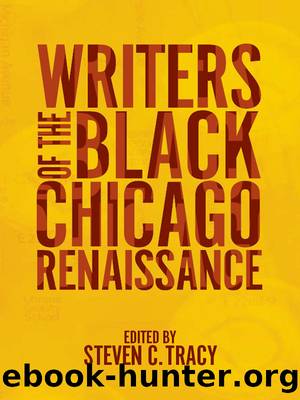Writers of the Black Chicago Renaissance by Steven C. Tracy

Author:Steven C. Tracy
Language: eng
Format: epub
Publisher: University of Illinois Press
Published: 2012-11-15T00:00:00+00:00
Notes
1. Himes, Chester. âLonely Crusade.â Chicago Daily Sun-Times, October 2, 1947, 33.
2. âStand Up and Be Counted.â Time (June 7, 1963): 11.
3. âNegro Art in Chicago.â Opportunity 18, 1 (January 1940): 19â22, 28â31.
4. See the discussion in Adam Meyer, âThe Need for Cross-Ethnic Studies,â MELUS 16, 4 (Winter 1989âWinter 1990): 19â39.
5. Kunitz, Stanley J., ed. âWillard Motley.â In Twentieth Century Authors: A Biographical Dictionary, First Supplement. New York: H. W. Wilson Co., 1955, 693â94.
6. In 1993 I visited the Motley collections at Northern Illinois University and University of Wisconsin, as well as conducted interviews with Frederica Motley (Chicago), Archibald Motley Jr. (Chicago), Ted Pierce (Madison, Wisconsin), Frank Fried (Berkeley, by phone), Alexander Saxton (Lone Pine, California, by phone), and Milton Zaslow (Laguna Beach, by phone). In 2003 I conducted a phone interview with Zev Braun (Los Angeles). My research in Chicago and Madison was carried out with the assistance of Patrick Quinn of Northwestern University Archives, to whom I am much indebted.
For this essay, I have combined new information with the standard sources that are cited in footnotes and the bibliography of additional readings. The most widely-available work on Motley is Robert F. Flemingâs Willard Motley (Boston: Twayne, 1978).
7. See Motleyâs memoir of his experiences in the Chicago Defender (National Edition): âFirst Bud Billiken Tells about Himself after 15 Years,â January 20, 1940, 19; January 27, 1940, 19; February 3, 1940, 19; February 17, 1940, 19.
8. Rayson, Ann. âPrototypes of Nick Romano of Knock on Any Door.â Negro American Literature Forum 8 (Fall 1974): 248â51.
9. âHull-House Neighborhood,â Hull-House Magazine 1, 1 (November 1939): 5â7; âPavement Portraits,â Hull-House Magazine 1, 2 (December 1939): 2â6; âHandfuls,â Hull-House Magazine 1, 3 (January 1940): 9â11.
10. The manuscript can be found in the Motley collection at Northern Illinois University, Dekalb.
11. The manuscript can be found in the Motley papers at Northern Illinois University, Dekalb.
12. Weyant, Nancy Jill. âThe Craft of Willard Motleyâs Fiction.â Dissertation, Northern Illinois University, 1975.
13. This manuscript can be found in the Motley papers at University of Wisconsin, Madison.
14. See Margaret B. Hexter, âFrom Altar-Boy to Killer,â Saturday Review of Literature 30 (May 24, 1947): 13; and Charles Lee, âDisciple of Dreiser,â New York Times Book Review, May 4, 1947, 3.
15. Motley, Willard. Knock on Any Door. New York and London: Appleton-Century, 1947, 503.
16. Ibid., 60.
17. Ibid., 88.
18. Ibid., 185.
19. Ibid., 189.
20. See Sidney Lens, Unrepentant Radical: An American Activistâs Account of Five Turbulent Decades. Boston: Beacon, 1980, 150â55.
21. Cain, James M. âInto the Lower Depths.â New York Times Book Review, November 18, 1951, 4, 34.
22. Swados, Harvey. âAngry Novel.â Nation 173 (December 29, 1951): 572.
23. Kingery, Robert E. Review of We Fished All Night. Library Journal 76 (December 1, 1951): 2006.
24. Anonymous. âThe â30s Revisited.â Time 58 (November 26, 1951): 120, 122.
25. Anonymous. âThe Wire-Recorder Ear.â Time 72 (August 11, 1958): 74.
26. Anonymous. Review of Let No Man Write My Epitaph. New Yorker 34 (August 23, 1958): 92.
27. Algren, Nelson. âEpitaph Writ in Syrup.â Nation 187 (August 16, 1958): 79.
28. This analysis is promoted in Robert A.
Download
This site does not store any files on its server. We only index and link to content provided by other sites. Please contact the content providers to delete copyright contents if any and email us, we'll remove relevant links or contents immediately.
Harry Potter and the Prisoner of Azkaban by J K Rowling(3516)
The Sentinel (Jack Reacher) by Lee Child & Andrew Child(3291)
Harry Potter and the Prisoner of Azkaban by Rowling J K(3074)
The Tales of Beedle the Bard by J.k.rowling (eng)(2700)
Dungeon Crawler Carl by Matt Dinniman(2126)
The Gate of the Feral Gods: Dungeon Crawler Carl Book 4 by Matt Dinniman(1972)
Marauder (The Oregon Files) by Clive Cussler & Boyd Morrison(1920)
Better Off Dead by Lee Child & Andrew Child(1897)
The Other Emily by Dean Koontz(1659)
Migrations by Charlotte McConaghy(1621)
The Girl and the Mountain by Mark Lawrence(1613)
Gild (The Plated Prisoner Series Book 1) by Raven Kennedy(1609)
Mark Z. Danielewski's House of Leaves by Mark Z. Danielewski & Johnny Truant(1517)
A Desolation Called Peace by Arkady Martine(1503)
Ruthless Empire (Royal Elite Book 6) by Rina Kent(1490)
Near the Bone by Christina Henry(1470)
The OP MC: God of Winning by Logan Jacobs(1432)
Fable: A Novel by Adrienne Young(1428)
The Captive by Fiona King Foster(1393)
